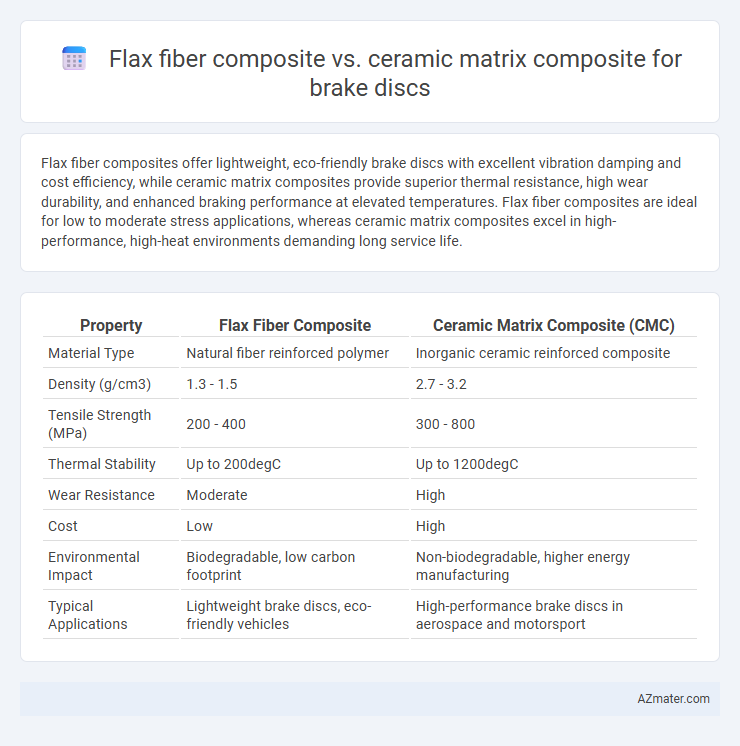Flax fiber composites offer lightweight, eco-friendly brake discs with excellent vibration damping and cost efficiency, while ceramic matrix composites provide superior thermal resistance, high wear durability, and enhanced braking performance at elevated temperatures. Flax fiber composites are ideal for low to moderate stress applications, whereas ceramic matrix composites excel in high-performance, high-heat environments demanding long service life.
Table of Comparison
| Property | Flax Fiber Composite | Ceramic Matrix Composite (CMC) |
|---|---|---|
| Material Type | Natural fiber reinforced polymer | Inorganic ceramic reinforced composite |
| Density (g/cm3) | 1.3 - 1.5 | 2.7 - 3.2 |
| Tensile Strength (MPa) | 200 - 400 | 300 - 800 |
| Thermal Stability | Up to 200degC | Up to 1200degC |
| Wear Resistance | Moderate | High |
| Cost | Low | High |
| Environmental Impact | Biodegradable, low carbon footprint | Non-biodegradable, higher energy manufacturing |
| Typical Applications | Lightweight brake discs, eco-friendly vehicles | High-performance brake discs in aerospace and motorsport |
Introduction to Brake Disc Materials
Brake discs require materials with high thermal resistance, wear durability, and mechanical strength to ensure effective braking performance and safety. Flax fiber composites offer lightweight, renewable options with good vibration damping but lower thermal stability compared to ceramic matrix composites, which provide superior heat resistance, hardness, and longevity in high-friction environments. The choice between flax fiber composites and ceramic matrix composites depends on balancing weight savings and environmental benefits against thermal performance and durability demands in automotive brake systems.
Overview of Flax Fiber Composites
Flax fiber composites are sustainable materials made from natural flax fibers embedded in a polymer matrix, offering excellent specific strength and lightweight properties ideal for brake disc applications. These composites provide enhanced vibration damping and improved wear resistance compared to conventional materials, making them suitable for reducing noise and extending disc lifespan. Their biodegradability and lower manufacturing energy requirements position flax fiber composites as eco-friendly alternatives to traditional ceramic matrix composites in automotive braking systems.
Overview of Ceramic Matrix Composites
Ceramic matrix composites (CMCs) are engineered materials consisting of ceramic fibers embedded within a ceramic matrix, offering superior heat resistance and wear performance critical for brake disc applications. Unlike flax fiber composites, CMCs provide exceptional thermal stability at temperatures exceeding 1000degC, ensuring consistent braking efficiency under extreme conditions. Their lightweight nature combined with high fracture toughness results in enhanced brake disc durability and reduced overall vehicle weight.
Mechanical Properties Comparison
Flax fiber composites exhibit lower density and superior impact resistance but provide moderate tensile strength and stiffness compared to ceramic matrix composites (CMCs), which feature significantly higher hardness, compressive strength, and thermal stability essential for high-performance brake discs. CMCs maintain structural integrity at elevated temperatures above 1000degC, outperforming flax composites whose mechanical properties degrade beyond 200degC. The superior wear resistance and fracture toughness of CMCs make them preferable for demanding braking applications requiring long-term durability and thermal resilience.
Thermal Performance and Heat Resistance
Flax fiber composites exhibit lower thermal conductivity and heat resistance compared to ceramic matrix composites, making them less effective in high-temperature brake disc applications. Ceramic matrix composites offer superior thermal stability and can withstand extreme temperatures above 1000degC, ensuring consistent performance under intense braking conditions. The advanced heat dissipation characteristics of ceramic matrix composites significantly reduce thermal degradation and brake fade in high-performance braking systems.
Weight and Density Analysis
Flax fiber composites offer significantly lower density, typically around 1.3-1.5 g/cm3, compared to ceramic matrix composites (CMCs), which have densities ranging from 2.5 to 3.5 g/cm3, making flax composites advantageous for lightweight brake disc applications. The reduced weight of flax fiber composites enhances vehicle fuel efficiency and handling by decreasing unsprung mass, while ceramic composites provide superior thermal resistance and wear performance but at the cost of increased weight. Optimal brake disc design balances these factors, leveraging flax fiber composites for weight-sensitive applications and ceramics where high temperature stability is critical.
Environmental Impact and Sustainability
Flax fiber composites offer significant environmental benefits in brake disc applications due to their renewable, biodegradable properties and lower carbon footprint compared to ceramic matrix composites (CMCs), which involve energy-intensive manufacturing and non-recyclable materials. Flax fibers require less energy to produce and result in reduced greenhouse gas emissions, making them a more sustainable choice for lightweight brake components. Conversely, CMCs provide superior thermal resistance but pose disposal challenges and higher environmental costs throughout their lifecycle.
Cost and Manufacturing Considerations
Flax fiber composites offer significant cost advantages for brake disc manufacturing due to lower raw material prices and simpler processing techniques, making them suitable for budget-conscious applications. Ceramic matrix composites, while more expensive to produce owing to high-temperature sintering and complex fabrication processes, provide superior thermal resistance and wear performance for high-demand braking systems. Manufacturing flax composites involves conventional molding methods with reduced energy consumption, whereas ceramic composites require advanced equipment like chemical vapor infiltration, increasing overall production costs.
Application Suitability in Automotive Industry
Flax fiber composites offer lightweight and sustainable properties suitable for low- to mid-performance automotive brake discs, providing enhanced vibration damping and reduced production costs. Ceramic matrix composites excel in high-performance brake systems due to their superior heat resistance, wear durability, and lightweight strength, making them ideal for sports cars and heavy-duty vehicles. The selection depends on performance requirements, with flax fiber composites favored for eco-friendly, cost-sensitive applications and ceramic matrix composites preferred where thermal stability and longevity are critical.
Future Trends and Research Directions
Flax fiber composites offer promising eco-friendly alternatives to traditional brake discs, with ongoing research emphasizing enhanced thermal stability and improved wear resistance to meet automotive performance demands. Ceramic matrix composites (CMCs) continue to dominate high-performance applications due to their superior heat tolerance, reduced weight, and excellent friction characteristics, with future trends focusing on cost reduction and scalability for mass production. Emerging research explores hybrid composites combining flax fibers with ceramic matrices to synergize sustainability and high thermal endurance for next-generation brake disc materials.

Infographic: Flax fiber composite vs Ceramic matrix composite for Brake disc
 azmater.com
azmater.com